Never miss another geomagnetic storm. Sign up for Space Weather Alerts and you'll receive a text message when magnetic storms erupt. Aurora your guides and professional astronomers use this service. You can, too! | | |
GEOMAGNETIC STORM WATCH: Minor G1-class geomagnetic storms are possible on July 20th or 21st when a slow-moving CME is expected to hit Earth's magnetic field. The CME was hurled into space by an unstable filament of magnetism, which erupted on July 15th. Aurora alerts: SMS Text.
SOUTHERN LIGHTS SEEN BY SOFIA: NASA's famous airborne infrared observatory, SOFIA, is retiring later this year, but first, there's an item on its bucket list: The Southern Lights. Yesterday, July 17th, the Boeing 747 flew through the auroral oval south of New Zealand and photographed a magnificent display of aurora australis:
"Despite a bright moon, SOFIA's new aurora camera system managed to capture an outburst of activity at around 9:44pm NZ time," reports Ian Griffin of the Otago Museum in Dunedin. "We were flying at latitude 62 degrees south."
Griffin has been wanting to do this for years. "I noticed in 2016 that SOFIA regularly flies through the southern auroral oval, so I have been working to get a decent high resolution camera on board," he explains. "NASA has high engineering standards, so the Museum got a local engineering firm in Dunedin to produce two camera platforms (port and starboard) that fit into the seat tracks on the upper deck of SOFIA."
The new cameras can take pictures with a high cadence, every 5 to 10 seconds. Such rapid-fire photography may help researchers understand some strange things that have been happening in the southern auroral zone:

Above: All-sky images show an SAR evolving into STEVE over Dunedin, NZ. [more]
On March 17, 2015, Griffin and colleagues watched a red auroral arc (SAR) over New Zealand turn itself into STEVE. The two phenomena are supposed to have little to do with one another, and current theories can't explain how it happened. Cameras onboard SOFIA might catch the transformation again.
"I am hoping we may spot something interesting," says Griffin.
"The Museum’s camera system was aligned and tested on July 17th while SOFIA continued her primary science observations using the 2.5M onboard telescope," he adds. "The system is still not perfect, but I am hopeful we will get data on SOFIA's remaining flights south of New Zealand--maybe up to 4 more flights!" Stay tuned.
Realtime Aurora Photo Gallery
Free: Spaceweather.com Newsletter
HUGE SOLAR PROMINENCE MIGHT BE COMING APART: For days, astronomers have been monitoring a huge prominence on the sun. It might be coming apart. On Saturday, July 16th, Dr. Sebastian Voltmer watched part of the structure fly away:
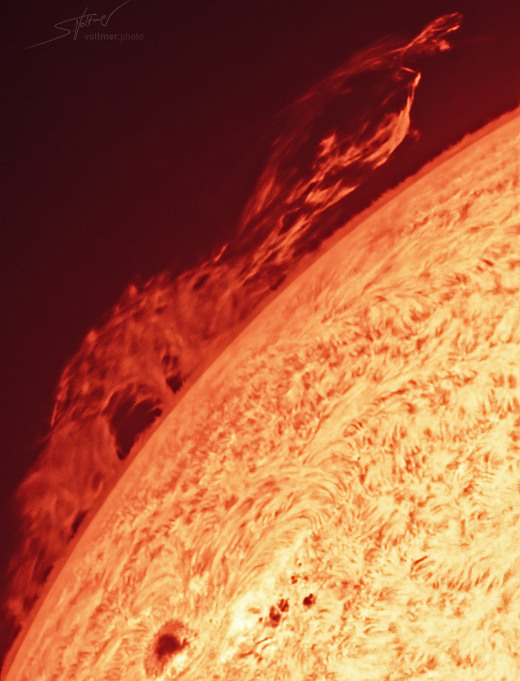
"The sheer size of the prominence is impressive," says Voltmer. "It was spectacular to see a very fast moving part of it ejecting and detaching to the side." Voltmer watched the action through a small refracting telescope protected by a Daystar Quark filter system.
Structures like this, in which hot plasma is held above the sun's surface by dynamic magnetic fields, are inherently unstable. The entire prominence could come down at any moment. If it falls today, amateur astronomers will get a fantastic side-on view of its disintegration. Solar flare alerts: SMS Text
more images: from Eduardo Schaberger Poupeau of Rafaela, Argentina; from Sylvain Weiller of Jerusalem, Israel ; from Pepe Manteca of Begues, Barcelona, Spain; from Maxime Spano of AstroVal Observatory, Switzerland; from Alessandro Bianconi of Dolianova, Italy; from Maximilian Teodorescu of Magurele, Romania; from P-M Hedén of Vallentuna, Sweden; from Jay Messeroff of Charleston, SC
Realtime Space Weather Photo Gallery
Free: Spaceweather.com Newsletter
STERLING SILVER TIGER HEART PENDANT: Are you looking for a far-out gift? Consider the sterling silver Tiger Heart Pendant. On June 26, 2022, this one hitched a ride to the stratosphere onboard an Earth to Sky Calculus cosmic ray research balloon:
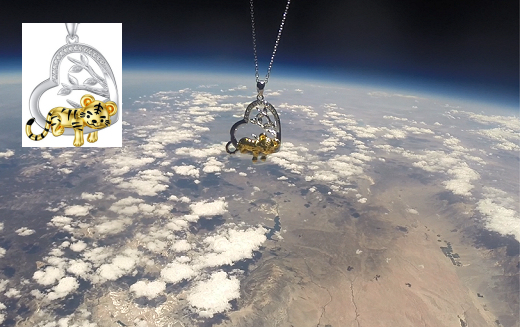
You can have it for $133.95. The golden tiger is surrounded by a partial halo of sparkling cubic zirconia crystals, tracing the shape of a heart. A rich layer of rhodium plating ensures the longevity of the pendant and its 18-inch chain.
The Tiger Heart Pendant makes a great anniversary, Christmas, or birthday gift. It comes with a greeting card showing the pendant in flight and telling the story of its trip to the stratosphere and back again.
Far Out Gifts: Earth to Sky Store
All sales support hands-on STEM education
Realtime Noctilucent Cloud Photo Gallery
Free: Spaceweather.com Newsletter
Every night, a network of
NASA all-sky cameras scans the skies above the United States for meteoritic fireballs. Automated software maintained by NASA's Meteoroid Environment Office calculates their orbits, velocity, penetration depth in Earth's atmosphere and many other characteristics. Daily results are presented here on Spaceweather.com.
On July 18, 2022, the network reported 9 fireballs.
(9 sporadics)
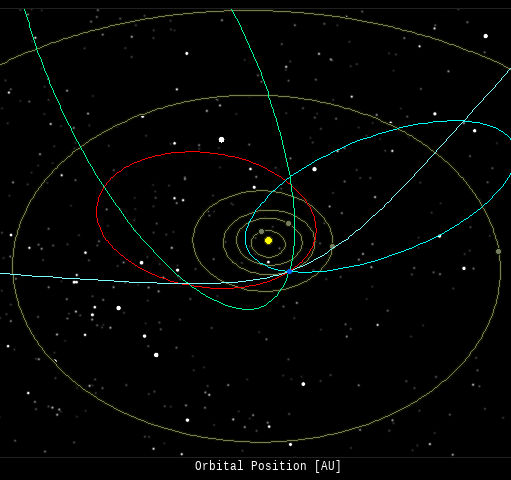
In this diagram of the inner solar system, all of the fireball orbits intersect at a single point--Earth. The orbits are color-coded by velocity, from slow (red) to fast (blue). [Larger image] [movies]
Potentially Hazardous Asteroids (
PHAs) are space rocks larger than approximately 100m that can come closer to Earth than 0.05 AU. None of the known PHAs is on a collision course with our planet, although astronomers are finding
new ones all the time.
On July 18, 2022 there were 2282 potentially hazardous asteroids.
 |
Recent & Upcoming Earth-asteroid encounters: | Asteroid | Date(UT) | Miss Distance | Velocity (km/s) | Diameter (m) |
| 2022 NY | 2022-Jul-14 | 7.2 LD | 8.2 | 26 |
| 2022 NC | 2022-Jul-14 | 7.6 LD | 7.5 | 34 |
| 2022 NJ | 2022-Jul-15 | 3.4 LD | 8.9 | 23 |
| 2022 LR1 | 2022-Jul-16 | 9.3 LD | 4.7 | 42 |
| 2022 KY4 | 2022-Jul-17 | 15.9 LD | 7.6 | 91 |
| 2021 OT | 2022-Jul-17 | 16.5 LD | 11.2 | 20 |
| 349068 | 2022-Jul-19 | 17.6 LD | 22.9 | 756 |
| 2017 RX2 | 2022-Jul-24 | 17.2 LD | 14.2 | 17 |
| 2022 NV1 | 2022-Jul-24 | 12.9 LD | 8.1 | 52 |
| 2022 ML3 | 2022-Jul-26 | 7.6 LD | 1.5 | 13 |
| 2022 NU1 | 2022-Jul-29 | 12.3 LD | 8.3 | 47 |
| 2016 CZ31 | 2022-Jul-29 | 7 LD | 15.6 | 129 |
| 531944 | 2022-Jul-30 | 18.2 LD | 5.9 | 192 |
| 2020 PP1 | 2022-Aug-01 | 13.1 LD | 3.7 | 17 |
| 2020 PN1 | 2022-Aug-03 | 9.7 LD | 4.6 | 29 |
| 2015 FF | 2022-Aug-12 | 11.2 LD | 9.2 | 17 |
| 2019 AV13 | 2022-Aug-22 | 19.1 LD | 8.8 | 135 |
| 2020 QW3 | 2022-Aug-22 | 14.1 LD | 18.1 | 30 |
| 2015 QH3 | 2022-Aug-22 | 5.6 LD | 7 | 14 |
| 2017 BU | 2022-Aug-29 | 15.8 LD | 7 | 32 |
| 2021 CQ5 | 2022-Sep-01 | 8.7 LD | 13.5 | 7 |
| 2020 PT4 | 2022-Sep-15 | 19.7 LD | 10.8 | 39 |
Notes: LD means "Lunar Distance." 1 LD = 384,401 km, the distance between Earth and the Moon. 1 LD also equals 0.00256 AU. MAG is the visual magnitude of the asteroid on the date of closest approach. | | Cosmic Rays in the Atmosphere |
SPACE WEATHER BALLOON DATA: Almost once a week, Spaceweather.com and the students of Earth to Sky Calculus fly space weather balloons to the stratosphere over California. These balloons are equipped with sensors that detect secondary cosmic rays, a form of radiation from space that can penetrate all the way down to Earth's surface. Our monitoring program has been underway without interruption for 7 years, resulting in a unique dataset of in situ atmospheric measurements.
Latest results (Nov. 2021): Our balloons have just measured a sudden drop in atmospheric radiation. It happened during the strong geomagnetic storms of Nov. 3-4, 2021. Here are the data:
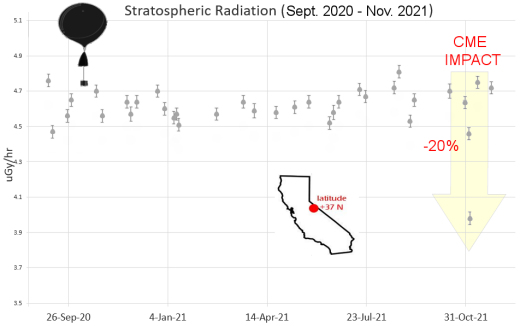
This is called a "Forbush decrease," named after American physicist Scott Forbush who studied cosmic rays in the early 20th century. It happens when a CME from the sun sweeps past Earth and literally pushes cosmic rays away from our planet. Radiation from deep space that would normally pepper Earth's upper atmosphere is briefly wiped out.
We have measured Forbush decreases before. For example, here's one from Sept. 2014. The Forbush Decrease of Nov. 3-4, 2021, was the deepest in the history of our 7-year atmospheric monitoring program. Radiation levels in the stratosphere over California dropped nearly 20%, more than doubling the previous record from our dataset.
En route to the stratosphere, our sensors also pass through aviation altitudes, so we can sample radiation where planes fly. This plot shows how the Forbush decrease was restricted to the stratosphere; it did not affect lower levels of the atmosphere:
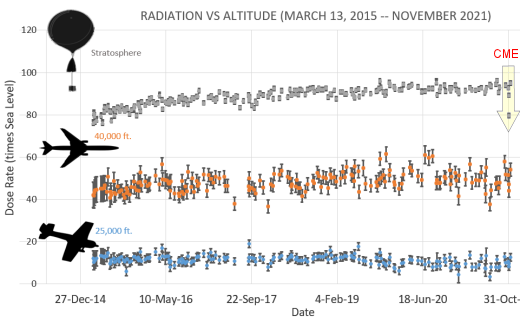
The dose rates shown above are expressed as multiples of sea level. For instance, we see that boarding a plane that flies at 25,000 feet exposes passengers to dose rates ~10x higher than sea level. At 40,000 feet, the multiplier is closer to 50x. The higher you fly, the more radiation you will absorb.
.Who cares? Cosmic rays are a surprisingly "down to Earth" form of space weather. They can seed clouds, trigger lightning, and penetrate commercial airplanes. According to a study from the Harvard T.H. Chan school of public health, crews of aircraft have higher rates of cancer than the general population. The researchers listed cosmic rays, irregular sleep habits, and chemical contaminants as leading risk factors. Somewhat more controversial studies (#1, #2, #3, #4) link cosmic rays with cardiac arrhythmias and sudden cardiac death.
.Technical notes: The radiation sensors onboard our helium balloons detect X-rays and gamma-rays in the energy range 10 keV to 20 MeV. These energies span the range of medical X-ray machines and airport security scanners.
Data points in the first graph ("Stratospheric Radiation") correspond to the peak of the Regener-Pfotzer maximum, which lies about 67,000 feet above central California. When cosmic rays crash into Earth's atmosphere, they produce a spray of secondary particles that is most intense at the entrance to the stratosphere. Physicists Eric Regener and Georg Pfotzer discovered the maximum using balloons in the 1930s and it is what we are measuring today.
| | The official U.S. government space weather bureau |
| | The first place to look for information about sundogs, pillars, rainbows and related phenomena. |
| | Researchers call it a "Hubble for the sun." SDO is the most advanced solar observatory ever. |
| | 3D views of the sun from NASA's Solar and Terrestrial Relations Observatory |
| | Realtime and archival images of the Sun from SOHO. |
| | information about sunspots based on the latest NOAA/USAF Active Region Summary |
| | from the NOAA Space Environment Center |
| | fun to read, but should be taken with a grain of salt! Forecasts looking ahead more than a few days are often wrong. |
| | from the NOAA Space Environment Center |
| | the underlying science of space weather |
 | BestCSGOGambling is the best site for everything related to CSGO gambling on the web |
 | To find reviews of new online casino sites in the UK try The Casino DB where there are hundreds of online casino reviews complete with bonuses and ratings. Alternatively, Online-Casinos.xyz is another massive directory of online casinos listing sites for the UK and Worldwide. Casinos that offer Rupees for bonuses are very generous to Indian players. Find the best online casinos in India at AllCasinos.in Looking for a new online casino? Try Casimpo the new site dedicated to making online casino simple, or check out the new Avenger Slots Casino and Ace Online Casino with over 500 online slots and casino games. |
 | One of the most popular casino games is the Book Of Dead Slot based on ancient Egyptian text, you can find all the casinos with spins at bookofdeadslotsites.com. |
 | When looking for casinos to play online when the weather is bad, you can try casino online trucchi for Italian games. If you are not from Finland you can try the Swedish page Svenska casino online to find suitable games, check out svenskacasinoonline.net. Always check your local laws before playing with real money. |
 | Looking for sports betting companies not registered on GamStop? CasinoGap has presented a list of sites not on GamStop available for UK players. Check and bet online! Would you like to bet at sites not using GamStop? Look at a list of NonStopCasino sites for online betting that aren't on GamStop. Top-rated bookmakers ever! |
| | These links help Spaceweather.com stay online. Thank you to our supporters! |
| | | | | | |

